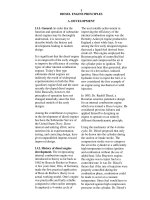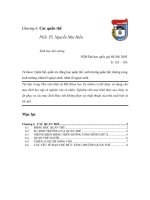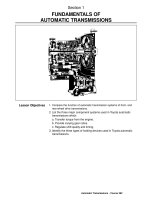Tài liệu PIC Robotics P1 ppt
Bạn đang xem bản rút gọn của tài liệu. Xem và tải ngay bản đầy đủ của tài liệu tại đây (2.45 MB, 30 trang )
PIC Robotics
This page intentionally left blank.
PIC Robotics
A Beginner’s Guide to
Robotics Projects
Using the PICmicro
John Iovine
McGrawHill
New York Chicago San Francisco Lisbon London Madrid
Mexico City
Milan
New Delhi
San Juan
Seoul
Singapore Sydney Toronto
Copyright © 2004 by The McGrawHill Companies, Inc. All rights reserved.
Manufactured in the United States of America. Except as permitted under the United
States Copyright Act of 1976, no part of this publication may be reproduced or dis
tributed in any form or by any means, or stored in a database or retrieval system,
without the prior written permission of the publisher.
0071394559
The material in this eBook also appears in the print version of this title:
0071373241.
All trademarks are trademarks of their respective owners. Rather than put a trade
mark symbol after every occurrence of a trademarked name, we use names in an edi
torial fashion only, and to the benefit of the trademark owner, with no intention of
infringement of the trademark. Where such designations appear in this book, they
have been printed with initial caps.
McGrawHill eBooks are available at special quantity discounts to use as premiums
and sales promotions, or for use in corporate training programs. For more informa
tion, please contact George Hoare, Special Sales, at george_hoare@mcgrawhill.com or
(212) 9044069.
TERMS OF USE
This is a copyrighted work and The McGrawHill Companies, Inc. (“McGrawHill”)
and its licensors reserve all rights in and to the work. Use of this work is subject to
these terms. Except as permitted under the Copyright Act of 1976 and the right to
store and retrieve one copy of the work, you may not decompile, disassemble, reverse
engineer, reproduce, modify, create derivative works based upon, transmit, distribute,
disseminate, sell, publish or sublicense the work or any part of it without McGraw
Hill’s prior consent. You may use the work for your own noncommercial and personal
use; any other use of the work is strictly prohibited. Your right to use the work may
be terminated if you fail to comply with these terms.
THE WORK IS PROVIDED “AS IS.” McGRAWHILL AND ITS LICENSORS MAKE
NO GUARANTEES OR WARRANTIES AS TO THE ACCURACY, ADEQUACY OR
COMPLETENESS OF OR RESULTS TO BE OBTAINED FROM USING THE
WORK, INCLUDING ANY INFORMATION THAT CAN BE ACCESSED THROUGH
THE WORK VIA HYPERLINK OR OTHERWISE, AND EXPRESSLY DISCLAIM
ANY WARRANTY, EXPRESS OR IMPLIED, INCLUDING BUT NOT LIMITED TO
IMPLIED WARRANTIES OF MERCHANTABILITY OR FITNESS FOR A PARTIC
ULAR PURPOSE. McGrawHill and its licensors do not warrant or guarantee that
the functions contained in the work will meet your requirements or that its operation
will be uninterrupted or error free. Neither McGrawHill nor its licensors shall be
liable to you or anyone else for any inaccuracy, error or omission, regardless of cause,
in the work or for any damages resulting therefrom. McGrawHill has no responsi
bility for the content of any information accessed through the work. Under no cir
cumstances shall McGrawHill and/or its licensors be liable for any indirect,
incidental, special, punitive, consequential or similar damages that result from the
use of or inability to use the work, even if any of them has been advised of the possi
bility of such damages. This limitation of liability shall apply to any claim or cause
whatsoever whether such claim or cause arises in contract, tort or otherwise.
DOI: 10.1036/0071394559
For more information about this title, click here.
Contents
Preface xi
Chapter 1. Robot Intelligence 1
What Is a Microcontroller? 1
Why Use a Microcontroller? 1
Designer Computers—So Many Microcontrollers 2
The Compiler 2
PIC Programming Overview 2
Software and Hardware 2
PicBasic and PicBasic Pro Compilers 3
EPIC Programmer 4
Firmware 5
Consumables 5
16F84 PIC Microcontroller 5
Step 1: Writing Code (the Basic Program) 6
Step 2: Using the Compiler 7
Step 3: Installing the Firmware, or Programming the PIC Chip 7
Ready, Steady, Go 8
Parts List 8
Chapter 2. Installing the Compiler 11
Installing the PicBasic Compiler Software 11
Installing the PicBasic Pro Compiler 12
Chapter 3. Installing the EPIC Software 19
Installing the EPIC Software in Windows 19
Installing the EPIC Software, DOS Version 22
Supplemental—Applications Directory
22
Chapter 4.
CodeDesigner
23
CodeDesigner Features
23
Software Installation
25
v
vi Contents
Setting CodeDesigner Options 25
First Program 31
The EPIC Programming Board Software 33
Parts List 35
Chapter 5. Using DOS to Code, Compile, and Program 37
Compile 39
Programming the PIC Chip 43
The EPIC Programming Board Software 44
Using EPIC DOS Version 45
Continuing with the
wink.bas
Program 45
Chapter 6. Testing the PIC Microcontroller 49
The PIC Microntroller 49
The Solderless Breadboard 49
Three Schematics, One Circuit 50
Wink 53
Troubleshooting the Circuit 54
PIC Experimenter’s Board and LCD Display 54
PIC Experimenter’s Board 56
Use 56
Simple Experiment 58
Builtin LCD 60
Using the LCD: PicBasic and PicBasic Pro Examples 63
Introduction to Binary and the PIC Microcontroller 65
Using TRIS and Port Registers 68
Accessing the Ports for Output 70
Counting Program 71
Counting in Binary by 1 71
Input 72
The
button
Command 72
A
button
Example 74
peek
75
peek
and PicBasic Pro 76
Basic Input and Output Commands 77
Servomotors 78
Parts List 79
Chapter 7. Intelligence 83
Approaches to Building Intelligence
83
Where’s the Intelligence? 85
Layered Behavioral Responses 85
BehaviorBased Robotics 86
Chapter 8. Walter’s Turtle 87
BehaviorBased Robotics 87
William Grey Walter—Robotics Pioneer 87
Four Modes of Operation
88
Contents vii
Observed Behavior 88
89
90
91
97
99
100
101
104
107
109
112
114
115
121
121
121
121
121
123
123
Building a Walter Tortoise
Drive and Steering Motors
Modifying the HS425BB Servomotor
Sheet Metal Fabrication
Shell
Finding the Center of Gravity
Attaching Bumper to Robot Base
Bumper Switch
Mounting the Steering Servomotor
Photoresistor
Trimming the Sensor Array
Schematic
Program
Adding Sleep Mode
Power
Behavior
Fudge Factor
Light Intensity
Handedness
Parts List
Chapter 9. Braitenberg Vehicles 125
Neural I/O Relationships 126
126
128
129
131
133
137
139
139
Vehicles
Building Vehicles
Back Wheels
Front Wheels
CdS Photoresistor Cells
Trimming the Sensor Array
PIC 16F84 Microcontroller
Testing
Second Braitenberg Vehicle (Avoidance Behavior) 141
Parts List 141
Chapter 10. Hexapod Walker 143
Imitation of Life 143
Six Legs—Tripod Gait 143
ThreeServomotor Walker Robot 144
Function 144
Moving Forward
145
Moving Backward 146
Turning Left 147
Turning Right 148
Construction
148
Mounting the Servomotors 151
Leg Positioning
152
Linkage 154
viii Contents
Center (Tilt) Servomotor 154
Sensors 155
Electronics 158
Microcontroller Program 159
Parts List 164
Chapter 11. Speech Recognition 165
Applications 167
Software Approach 167
Learning to Listen 167
SpeakerDependent and SpeakerIndependent Recognition 167
Recognition Style 168
Speech Recognition Circuit 168
Circuit Construction 168
Keypad 169
To Train 169
Testing Recognition 172
Error Codes 172
Clearing the Trained Word Memory 172
Independent Recognition System 172
Voice Security System 173
Speech Interface Control Circuit 173
How the Circuit Works 174
PIC 16F84 Microcontroller Program 176
Active High Output 177
SPDT Relay Output 177
Circuit Construction 177
Programming the Speech Recognition Circuit: Training, Testing, and Retraining 177
SRI02 and SRI03 Interfaces 180
Robot Control 180
Parts List 181
Chapter 12. Robotic Arm 185
Servomotor Building Blocks for Robotics 185
Basic Servomotor Bracket Assembly 186
Assembling MultipleServomotor Assemblies 189
Building a FiveServomotor Robotic Arm 192
Servomotors 197
Servomotor Controllers 199
Simple Servomotor Controller 200
Four and FiveServomotor Controllers
204
Increasing the Lifting Capacity of the Robotic Arm 215
Adding a Robotic Arm Base 216
Parts List 223
Chapter 13. Bipedal Walker Robot 225
A Question of Balance? 226
A Little Feedback 227
Servomotors 227
Contents ix
Servomotor Brackets 228
Footpads 228
Assembly 230
Schematic 231
Program 233
Subroutines M1, M2, and M3 234
Going Further 241
Turning Right and Left 242
Parts List 242
Chapter 14. Color Robotic Vision System 243
CMU Camera 244
Serial Communication 245
VB Application Program 248
Interfacing the CMU Camera to a Robot 250
PIC 16F84 Runs at 16 MHz 251
Program 1 251
Program 2 254
Incandescent or Fluorescent Lighting 254
Servomotors for Robot 259
Program 3 261
Robot Construction 264
Running the Program 266
Going Further 267
Parts List 267
Suppliers 269
Index 271
This page intentionally left blank.









